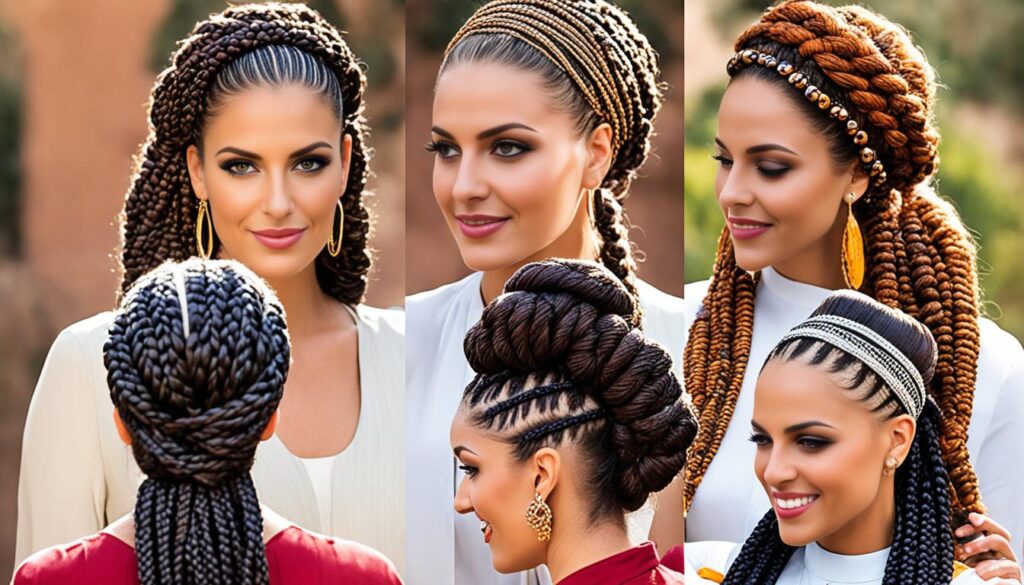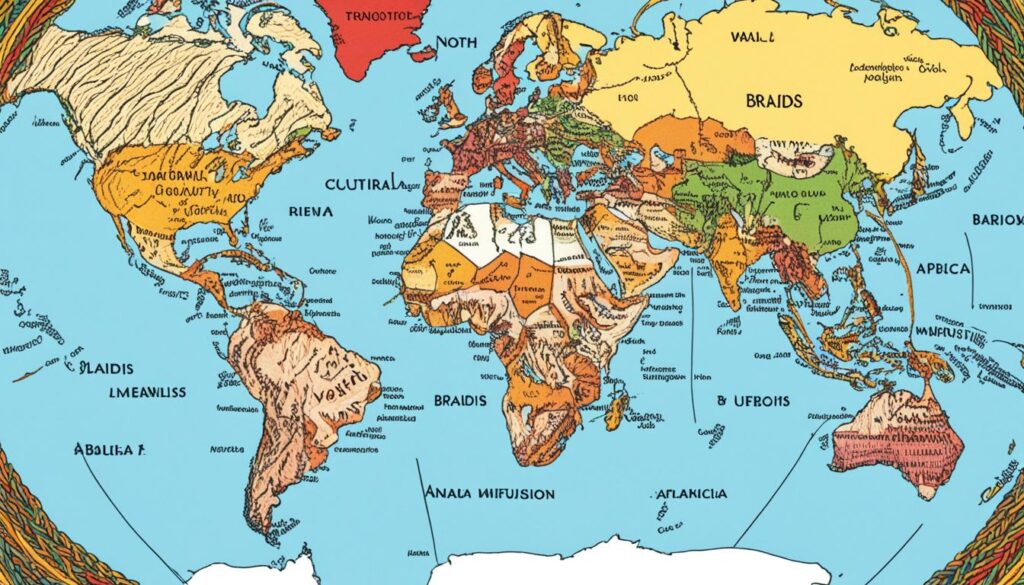
When it comes to hairstyles, the world is a vibrant tapestry of diverse traditions and cultural expressions. From elaborate updos to sleek ponytails, hair has always been an important part of personal identity and cultural heritage. But what about braids? Can North Africans wear braids like their African counterparts, or is it a form of cultural appropriation?
The perception of beauty in the United States has traditionally favored straight hair, but globally, beauty includes textured styles like braids, twists, Locs, and curls. Braids have become a bold and beautiful look embraced by mainstream media, models, and actresses. But what about North Africans? Are they allowed to wear braids despite their non-black appearance?
In this article, we will explore the cultural significance of braids in North Africa, the unique North African hairstyles and braiding techniques, the ongoing debate of cultural appropriation, the importance of embracing diversity in braided hairstyles, and the global influence of braids. So, let’s delve into the rich tapestry of North African hairstyles and discover the truth about braids!
Key Takeaways:
- Braids hold cultural significance in North Africa, representing heritage, identity, and tradition.
- North African hairstyles showcase a wide range of braiding techniques and patterns.
- The history of braids raises concerns about cultural appropriation, but it is important to recognize and respect the origins of these hairstyles.
- Diversity in braided hairstyles allows for personalization and fusion of different cultural influences.
- Braids have a global influence, with people from various cultures embracing them as a form of self-expression.
The Cultural Significance of Braids in North Africa
Braids hold a deep cultural significance in North Africa, representing heritage, identity, and tradition. These intricate hairstyles are not mere fashion statements, but symbols that communicate various aspects of a person’s life. Through different braiding styles, individuals convey their social status, age, and marital status, while also connecting to their African roots. Despite the misconception that North Africans are not black, their braiding traditions and African heritage are integral parts of their culture.
| Braiding Style | Symbolism |
|---|---|
| Fula women’s braids | Five long braids down the back with a tuft of hair gathered at the top |
| Symbolizes Fula heritage | |
| Indicates marital status and social status | |
| Passed down through generations | |
| Connects individuals to their African roots |
These braided hairstyles are not limited to aesthetic choices but are a part of a wider cultural narrative. They serve as a celebration of African heritage and an affirmation of cultural identity. By preserving and passing down these braiding traditions, individuals in North Africa continue to forge a strong connection to their roots, embracing their African ancestry.
These braided hairstyles reflect the diversity and richness of North African culture. They are not just a hair trend but a powerful symbol of the cultural vibrancy and complexity of the region.
Braids have the power to transcend boundaries, serving as a form of self-expression and artistry. They embody the resilience, creativity, and beauty of North Africa, creating a visual language that speaks volumes about the people and their history. It is important to recognize and appreciate the cultural significance of braids, understanding that they are deeply rooted in the African heritage of North Africa.
North African Hairstyles and Braiding Techniques
North African hairstyles encompass a rich variety of braiding techniques and patterns that reflect the cultural diversity and artistic heritage of the region. Traditional braiding techniques in Morocco, Algeria, and Tunisia are characterized by their elaborate braid patterns and intricate designs, often reserved for special occasions and celebrations.
These hairstyles serve as a testament to the historical and cultural significance of braids in North Africa, where they are deeply ingrained in local customs and traditions. They not only serve as expressions of style and beauty but also convey social status and cultural identity.
Let’s take a closer look at the distinct North African braiding traditions:
Moroccan Hairstyles
In Morocco, braiding is an art form that has been passed down through generations. Moroccan hairstyles are renowned for their intricate designs and the use of decorative accessories such as beads, ribbons, and jewelry. These elaborate braids are often worn during weddings and other festive occasions, showcasing the skill and creativity of the hairstylist.
Algerian Hairstyles
In Algeria, braided hairstyles are an integral part of the cultural fabric. Algerian women traditionally adorn their hair with intricate braided patterns that symbolize their identity and heritage. The braids are meticulously woven to create geometric shapes and interlocking patterns, resulting in stunning and unique hairstyles that are both visually captivating and culturally significant.
Tunisian Hairstyles
Tunisian hairstyles are characterized by their elaborate braiding techniques and elaborate designs. Tunisian women often incorporate fabrics, ribbons, and colored threads into their braids, adding vibrant pops of color and texture. These braided hairstyles not only showcase the artistic skill of the hairstylist but also serve as a visual representation of cultural pride and heritage.
The following table provides a comparison of the key features of Moroccan, Algerian, and Tunisian hairstyles:
| Hairstyle | Characteristics |
|---|---|
| Moroccan Hairstyles | Elaborate designs Use of decorative accessories Worn during special occasions |
| Algerian Hairstyles | Intricate interlocking patterns Symbolic of identity and heritage Captivating geometric shapes |
| Tunisian Hairstyles | Elaborate braiding techniques Incorporation of fabrics and colored threads Showcasing cultural pride |

These North African hairstyles not only serve as a source of inspiration and admiration but also highlight the beauty and diversity of braiding techniques across the region. By preserving and celebrating these traditional braiding techniques, North Africans pay homage to their cultural heritage while also contributing to the global tapestry of hairstyling artistry.
Braids and Cultural Appropriation
The history of braids being worn by various cultures around the world raises concerns about cultural appropriation. While braids have become popular globally, it is important to recognize and respect the origins of these hairstyles. The North African roots of French braids highlight the necessity of understanding and appreciating the cultural significance behind braided hairstyles. Respectful appreciation of braided hairstyles involves acknowledging and honoring their African heritage.
Appreciation versus appropriation is a delicate balance. Cultural appreciation involves understanding and celebrating the significance of different cultural practices, while cultural appropriation involves taking elements of a culture without understanding or respecting their meaning. When it comes to braids, it is crucial to appreciate these traditions without appropriating them. This means recognizing that indigenous African communities have been wearing braids for centuries and giving credit to their cultural contributions.
“Cultural appreciation is about recognizing and showcasing various cultures and their practices with respect, while cultural appropriation is the commodification and exploitation of those practices without understanding or acknowledging their origins.” – Celebrity hairstylist Patrice|Renee
Recognizing the origins of braids is essential in order to avoid cultural appropriation. Braided hairstyles have deep cultural and historical significance for many African communities. They have been used as a means of identity expression, conveying social status, and preserving cultural heritage. By understanding the cultural context and history behind braids, we can appreciate them in a respectful and inclusive manner.
Appreciation of braided hairstyles can be further enhanced by learning and educating others about the cultural significance behind different braiding traditions from around the world. This can help create a more informed and respectful dialogue around the topic of braids, fostering understanding and cultural exchange.
It is important to remember that cultural appreciation should never be used as a form of cultural exploitation or as a means to profit off someone else’s culture. When appreciating and embracing braided hairstyles, it is crucial to approach them with an attitude of respect, authenticity, and understanding. By doing so, we can celebrate the diversity and beauty of braids while honoring the cultures from which they originate.
Embracing Diversity in Braided Hairstyles
The beauty and versatility of braided hairstyles allow for diverse interpretations and adaptations. People from different cultures can embrace and incorporate elements of braiding into their own styles while still acknowledging and respecting the roots of these traditions.
In modern times, braided hairstyles have evolved to reflect the cultural fusion and diversity of our society. Traditional braiding techniques are being combined with contemporary elements, resulting in unique and innovative styles that celebrate cultural exchange.
Modern Interpretations of Braids
Modern interpretations of braids take inspiration from various cultures and incorporate new techniques, materials, and styles. Braided hairstyles are no longer limited to specific cultural communities but have become a global fashion statement embraced by individuals of all backgrounds. These hairstyles allow for personal expression and creativity, empowering individuals to explore their own unique sense of style.
The beauty of embracing diverse braided hairstyles lies in the opportunity to learn from each other’s cultures and celebrate the rich heritage that has influenced these beautiful hairdos.
Cultural Fusion in Braided Hairstyles
Cultural fusion in braided hairstyles is evident in the incorporation of different braiding techniques and cultural symbols. For example, African braiding techniques may be combined with elements of Native American, Asian, or European styles, resulting in mesmerizing combinations that reflect the diverse identities of those who wear them.
The fusion of cultures in braided hairstyles serves as a visual representation of our interconnected world and promotes a sense of unity and understanding among individuals from various backgrounds. It’s a powerful way to break down barriers, foster cultural appreciation, and celebrate diversity.
Examples of Cultural Fusion in Braided Hairstyles
| Cultural Influence | Braided Hairstyle |
|---|---|
| African | Cornrows with bead accents |
| Native American | Feathered braids |
| Asian | Goddess-inspired braided updo |
| European | Messy braided bun |
This table showcases examples of braided hairstyles that incorporate diverse cultural influences. Each style represents a unique fusion of traditions, creating a truly global and inclusive fashion statement.
By embracing diversity in braided hairstyles and acknowledging the cultural fusion that occurs, we celebrate the beauty of different traditions and promote a more inclusive and understanding society.
The Evolution of Braids in Modern Times
Braids have continued to evolve throughout history and remain a popular choice in modern times. From their cultural significance to their contemporary appeal, braided hairstyles have undergone significant transformations over the years.
The Black is Beautiful movement of the 1960s and 1970s played a crucial role in empowering African-Americans to embrace their natural beauty, including braided hairstyles. This movement celebrated the uniqueness of black hair and challenged traditional beauty standards that favored straight hair. As a result, braids gained immense popularity as a symbol of African heritage and self-expression.
However, the impact of social media on braids cannot be overlooked. Platforms like YouTube have revolutionized the way people learn about and style their hair. Countless tutorials and inspirational content are readily available, making it easier for individuals to experiment with different braiding techniques and designs. Social media has not only facilitated the sharing of knowledge but has also fostered a sense of community among braiding enthusiasts.
Modern Braiding Trends
In recent years, modern braiding trends have emerged, incorporating new techniques and styles while building upon traditional foundations. Stylists and individuals are pushing the boundaries of creativity, resulting in innovative and unique braided hairstyles.
“Braids are a universal language of beauty, transcending cultural boundaries.”
The versatility of braids allows individuals to explore various looks, from intricate and elaborate designs to simpler, more minimalist styles. Whether it’s box braids, cornrows, or goddess braids, braided hairstyles offer endless possibilities for personal expression.
The Impact of Social Media on Braids
Thanks to the digital age, social media has played a transformative role in shaping the popularity and acceptance of braided hairstyles. Platforms like Instagram, Pinterest, and TikTok have become hubs for style inspiration, allowing people to discover new trends and showcase their own braided looks to a global audience.
By sharing their braided hairstyles on social media, individuals have not only influenced fashion and beauty trends but have also encouraged cultural exchange and appreciation. The seamless access to diverse braiding techniques and styles has led to a greater understanding and celebration of the beauty of braids across different cultures.

The evolution of braided hairstyles in modern times is a testament to their enduring appeal and cultural significance. From their roots in African heritage to their current status as a fashion statement, braids continue to hold a special place in the world of hair styling.
The Global Influence of Braids
Braids have become a global phenomenon, with people from various cultures and backgrounds embracing this hairstyle as a form of self-expression. The versatility of braids allows for customization and personalization, making it a popular choice worldwide.
From Native Americans to Caribbean cultures, braids, such as cornrows, are worn by both men and women, showcasing their cultural significance and beauty. In India, braided hairstyles are especially favored for weddings, symbolizing tradition and elegance.
Even ancient civilizations recognized the allure of braids. Egyptians and Greeks had their own unique braiding traditions, showcasing the enduring impact of this hairstyle over centuries.
Braids not only enhance one’s appearance but also serve as a conduit for cultural preservation and self-expression. They allow individuals to showcase their roots, celebrate their heritage, and express their unique sense of style.

The Popularity of Braids in Different Cultures
The popularity of braids transcends geographical borders and cultural boundaries. Let’s explore the diverse embrace of braided hairstyles in various cultures:
| Culture | Significance |
|---|---|
| Native Americans | Braids are an integral part of Native American culture, symbolizing tribal affiliation, identity, and spirituality. |
| Caribbean | Braids, particularly cornrows, are a cherished cultural tradition in many Caribbean countries, representing African heritage and pride. |
| India | Braided hairstyles hold great importance in Indian weddings, signifying marital bliss and tradition. |
| Inuit | Inuit braids, often adorned with intricate designs and beads, reflect their Arctic heritage and demonstrate their close connection to nature. |
The global popularity of braids showcases the universal appeal and undeniable beauty of this hairstyle. It serves as a testament to the power of self-expression and cultural exchange, allowing people from diverse backgrounds to connect through a shared love for braided hairstyles.
Conclusion
Braids hold a significant place in North African culture and are celebrated not only in this region but also in many cultures around the world. While there are ongoing discussions about cultural appropriation, it is crucial to distinguish between cultural appreciation and appropriation. North Africans, despite their non-black appearance, have a strong connection to their African heritage, allowing them to proudly wear and celebrate braided hairstyles.
By acknowledging and understanding the origins of these traditions, we can promote cultural appreciation and diversity in the world of braided hairstyles. It is important for individuals to educate themselves about the rich cultural significance of braids and to respect the customs and heritage that these hairstyles represent.
Celebrating braided hairstyles goes beyond any specific ethnicity or race. It is an opportunity to showcase the beauty and artistry that comes with diverse cultural identities. By embracing and honoring the cultural heritage behind braided hairstyles, we can foster a sense of unity and appreciation for the beauty in all its forms. So, whether you are North African or from any other background, let us continue to celebrate the diversity and richness of braided hairstyles.






